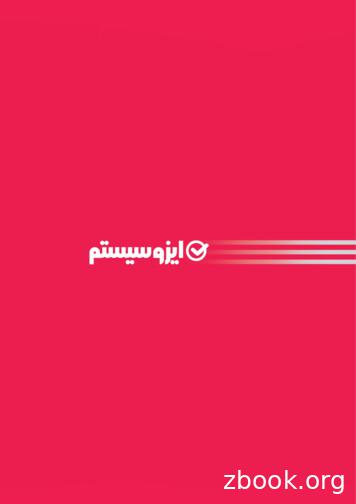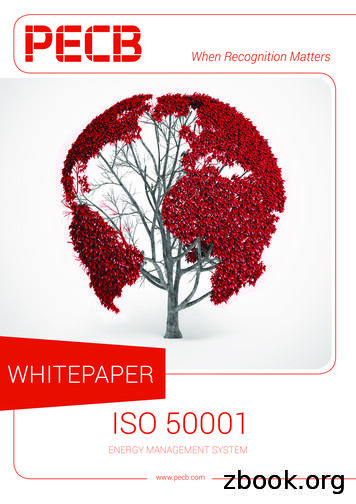ISO 14001, ISO 50001, ISO 26000, ISO 10002, ISO 16949
ISO 14001, ISO 50001, ISO 26000, ISO10002, ISO 16949Kristina ZhelibaDicle Solmaz105.10.2017
OUTLINEI.II.About ISOISO Types (Benefits and Key Requirements)I.ISO 14001II. ISO 50001III. ISO 26000IV. ISO 10002V. ISO 16949III. References2
About ationCentralSecretariat inGeneva162 nationalstandardsbodies3
About ISOThrough its members, it brings together experts to share knowledgeand develop voluntary, consensus-based, market relevant InternationalStandards that support innovation and provide solutions to globalchallenges.4
ISO 14001Environmental Management5
How ISO 14001 works and how itdelivers benefits for your company?Sustainability in an organizationImproved lifecycle perspectiveEnvironmental protectionIncreasing customer expectationsand regulatory requirements6
How ISO 14001 brings value to organization?Helps to keep consistencyHelps to apply common language across allstandardsHelps organizations to incorporate theirenvironmental management system into corebusiness processes7
Benefits of ISO 140018
Key Requirements for ISO 14001Clause 1: ScopeThis clause relates to the scope or coverage of the standard to helporganizations achieve the intended outcomes of its EMS.Clause 2: Normative referenceThe clause is retained in order to maintain the same numberingscheme as all the other management system standards.Clause 3: Terms and definitionsTerms and definitions are in the order that they appear in thestandard.9
Key Requirements for ISO 14001Clause 4: Context of the organization1.Determine external and internal issues.2.Establish, implement, maintain and continually improve the EMS.Clause 5: LeadershipThis clause is all about the role of “top management” which is the person orgroup of people who directs and controls the organization at the highest level.Clause 6: PlanningThis clause focuses on how an organization plans actions to address both risksand opportunities which have been identified in Clause 4.10
Key Requirements for ISO 14001Clause 7: SupportThe execution of the plans and processes that enable an organization to meettheir EMS.Clause 8: OperationClause 9: Performance EvaluationThis is all about measuring and evaluating your EMS to ensure that it is effectiveand it helps you to continually improve.Clause 10: ImprovementThis clause requires organizations to determine and identify opportunities forcontinual improvement of the EMS11
QUESTION 1Which one of the following is NOT a benefit of ISO 14001implementation?A. Helps to keep consistencyB. Helps to apply common language across all standardsC. Establishment the structure and discipline to ‘’cut energy costs andgreenhouse gas emissions’’12
Energy ManagementStandard13
ISO 50001 – Energy Management StandardISO 50001 is a proven framework for industrial facilities,commercial facilities, or entire organizations to manage energyEstablishment of the structure and discipline to ‘’cut energycosts and greenhouse gas emissions’’Can be implemented individually or integrated with otherstandards14
ISO 50001 – Benefits of Implementation Reduceenvironmentalimpact Establish positiveexternal relationsand public image Create transparencyon how energyresources are managed Raise awareness andcreate greateremployee stewardship Be able to identifyfuture projects Reduced operational andoverhead costs lead toincreased profitability Promote energyefficiency throughoutyour organization Reduced airemissions, such asGHGs15
QUESTION 2Which one of the following is a benefit of ISO 50001 implementation?A. Promote energy efficiency throughout your organizationB. Recognizing social responsibility and engaging stakeholdersC. Qualify to supply the automotive industry16
ISO 26000SOCIAL RESPONSIBILITY17
ISO 26000Organizations in the private, public, and nonprofit sectors,whether large or small, use ISO 26000Recognizing social responsibility and engaging stakeholdersIntegrate socially responsible behavior into the organizationThe seven key underlying principles of social responsibility18
ISO 26000 - Principles of Social ResponsibilityAccountabilityRespect forhuman rightsRespect forinternationalnorms ofbehaviorRespect for ruleof lawTransparencyEthical behaviorRespect forstakeholderinterest19
QUESTION 3ISO 26000 defines seven principles of social responsibility. Which of thefollowing is not a principle of ISO 26000?A. Ethical behaviorB. Respect for human rightsC. Customer focus20
ISO 10002Quality management — Customersatisfaction — Guidelines forcomplaints handling inorganizations21
How ISO 10002 works?Improves complaints-handling processHelps to apply a systematic manner to solve complainsEnhance the ability of an organization to identify trends and eliminatecauses of complaintsHelp an organization create a customer-focused approach to resolvingcomplaints by improving personnel’s skillsProvide a basis for review and analysis of the complaints-handlingprocess22
Key Requirements for ISO 10002Gap analysis formal look on existing complaintsmanagement system and compare them with ISO 10002standards.Formal assessment reviewing an organizationreadiness for assessment accordingly to standards.Certification and beyond When an organization havepassed the formal assessment it will receive ISO10002 certificate.23
QUESTION 4Which of the following definition matches the ISO 10002?A. Provides guidance on the process of complaints handling related toproducts within an organization, including planning, design,operation, maintenance, and improvement.B. Based on ISO 9001 and includes specific requirements from theautomotive sector for the design/development, production,installation and servicing of all automotive-related products.C. Developed to help organizations effectively assess and addressthose ’’social responsibilities’’ that are relevant and significant totheir mission and vision; operations and processes; stakeholders;and environmental impact.24
ISO 16949AUTOMOTIVEQUALITYMANAGEMENTSYSTEM25
ISO 16949ISO 16949 is based on ISO 9001 and includes specific requirements fromthe automotive sector for the design/development, production,installation and servicing of all automotive-related productsISO/TS 16949 (1st) was created by the ‘’International Automotive TaskForce (IATF)’’ and other revisions 2nd&3rdIn 2016, the IATF published a revised standard, and the first edition will bereferred to as “IATF 16949.” This new replace the current ISO/TS16949:2009IATF (The International Automotive Task Force)26
ISO 16949 – Benefits of ImplementationImprovement of your credibility and imageQualify to supply the automotive industryImprovement of customer satisfactionBetter process integrationCreate a continual improvement culture27
QUESTION 5Is ISO/TS 16949 related to ISO 9001?A. Yes, it is based on ISO 9001 and has more details for automotiveindustry.B. No, it is a Technical Specification based on Military standard.C. Yes, it is just a different name of the same standard.28
REFERENCES Retrieved 25.09.2017 from 594DE/tng uk/iso-50001-guide-and-check-list-uk.pdf Retrieved 25.09.2017 from https://quality-one.com/iatf-16949/ Retrieved 28.09.2017 from y.html Retrieved 28.09.2017 from ndards/iso26000/ Retrieved 28.09.2017 from /about/ Retrieved 30.09.2017 from http://www.standartkalite.com/iso16949 otomotiv.htm Retrieved 30.09.2017 from atisfaction-and-Complaints-Handling/ Retrieved 01.10.2017 from https://www.iso.org/iso-and-consumers.html Retrieved 02.10.2017 from https://www.iso.org/standard/65712.html29
ISO 14001, ISO 50001, ISO 26000, ISO 10002, ISO 16949 Kristina Zheliba Dicle Solmaz 05.10.20171
ISO 50001:2018 TIMESCALES ISO 50001:2018 was published 22 August 2018 and is the replacement for ISO 50001:2011. For organizations currently using ISO 50001:2011 there is a three-year transition period to switch to ISO 50001:2018. STRUCTURE OF ISO 50001:2018 The structure of ISO 50001:2018 follows the high level structure being applied to all .
Ref.No.EN ISO 50001:2018 E National foreword This British Standard is the UK implementation of EN ISO 50001:2018. It is identical to ISO 50001:2018. It supersedes BS EN ISO 50001:2011, which is withdrawn. The UK participation in its preparation was e
ISO 50001 can be easily linked with ISO 9001 and ISO 14001. ISO 50001 focuses on energy efficiency, whilst ISO 14001 emphasizes the significant environmental impacts of an organization. Both s
ISO 14001 Internal Auditor Training (3 days) Course on planning, conducting, and reporting internal ISO 14001 audits. ISO 14001 Program Development (10) ISO 14001 Internal Audit (11) 28 ISO 14001 Advanced Training (5 days) Comprehensive course on system requirements and processes, implementation, and auditing. ISO 14001 Program
ISO 9001.2015 & ISO 14001.2015 Gap Analysis Checklists* ISO 9001.2015 & ISO 14001.2015 Internal Audit Checklists* ISO 9001 & ISO 14001 Employee Newsletters *Sample Included. ISO 9001:2015 QUALITY MANAGEMENT SYSTEM ***** ISO 14001:2015 ENVIRONMENTAL MANAGEMENT SYSTEM ***** QMS - EMS MANUAL Your Company Name
ISO 9001:2015 - ISO 14001:2015 - DIS2 ISO 45001:2017 - ISO 50001:2011 - ISO 22301:2012 001_22301 2.docx Ersteller: E. Bauer / Prüfer: W. Hackenauer 12/4 ISO 9001:2015 ISO 14001:2015 ISOISO DIS2 45001:2017 ISO 50001:2011 22301:2012 Qualitätsmanagement-system und seine Prozesse
ISO 9001:2015 QMS and ISO 14001:2015 EMS and ISO 45001:2018 Internal audit 6. Principals of Quality Management System-ISO 9001:2015 7. ISO 9001 and 14001 and ISO 45001:2018 EQHSMS audit records 8. Table of Documented information Summary against ISO 9001:2015 and ISO 14001:2015 require
Copyright 2013-2014 by Object Computing, Inc. (OCI). AngularJS ui-router All rights reserved. State Configuration . template, templateUrl or templateProvider .























